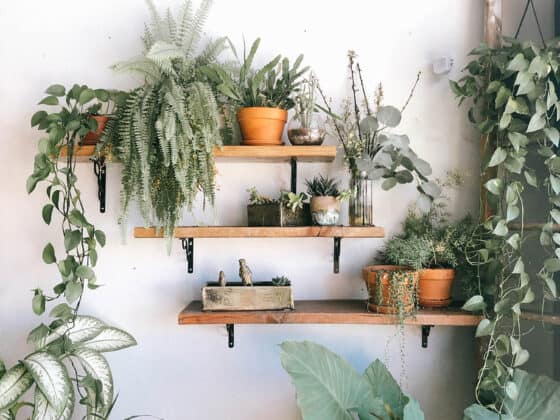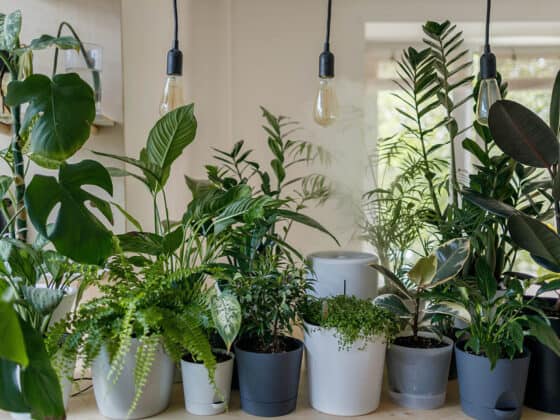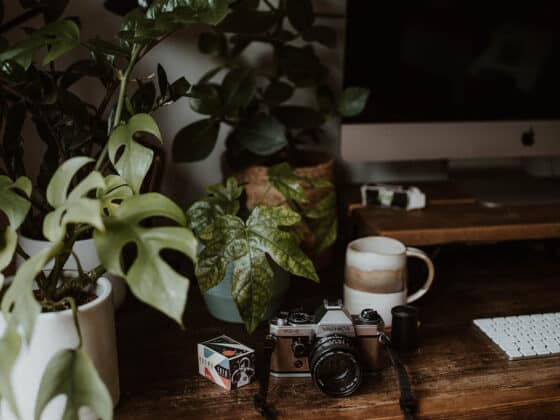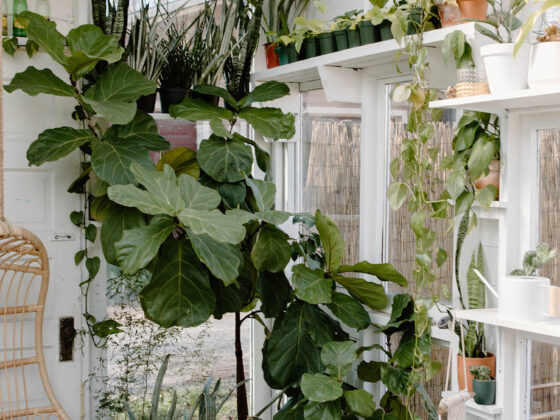Have you ever moved or jostled one of your cherished houseplants only to find a cloud of white specks burst from the foliage? If so, you are likely all too aware of the number of headaches a whitefly infestation can facilitate. What are these particularly persistent pests, and how do you get rid of them?
“Whitefly” is a common name applied to a large group of white, moth-like insects that are generally about 1/16” to 1/10” long and feed on the sap of plants. Although mostly considered a nuisance, severe whitefly infestations can cause significant plant health issues and will persist unless treatments are administered to the plant.
Because whiteflies are tiny insects with short lifecycles, a substantial population can grow very quickly. A plant will sustain increasing amounts of damage as the infestation grows, and the risk of other plants becoming infested is more likely. These insects also tend to be pretty resilient, with their small size being an advantage, often evading treatment methods despite several applications.
The good news is that if you know what to look for, whitefly infestations are fairly easy to identify. Treatment options are available that tend to be pretty effective in controlling their numbers, especially when infestations are lighter.
In this article, we’ll discuss what whiteflies are, what they look like, and several different ways you can treat for them once you’ve noticed their presence on your houseplant.
What Do Whiteflies Look Like?
Whiteflies describe a large family of sap-sucking insects that are most recognizable by their white, moth-like bodies and powdery wings. Most species of whitefly tend to only be around about 1/10” long and have a wedge or heart-shaped body.
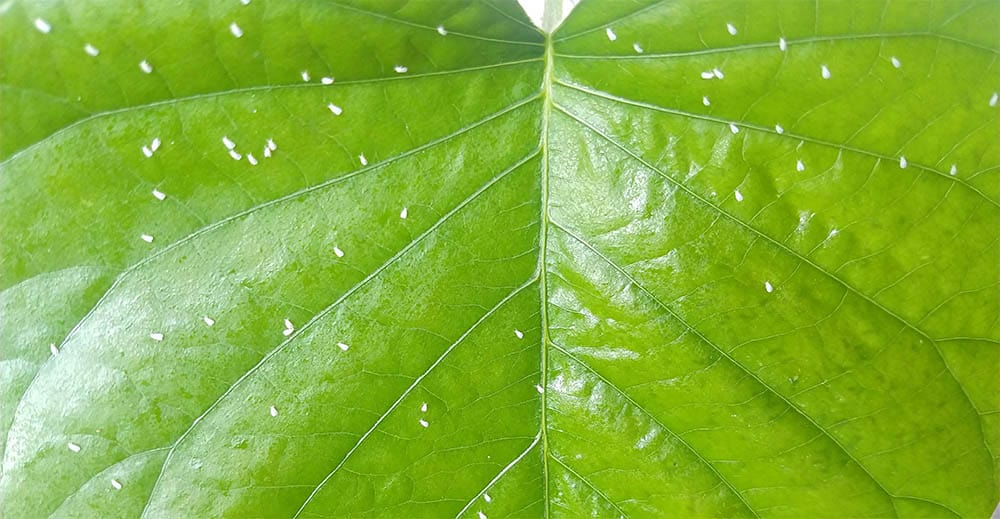
They are most easily recognized when they take flight after a plant is disturbed during movement or watering, resembling a cloud of small, white specks, like snowflakes, rising from foliage.
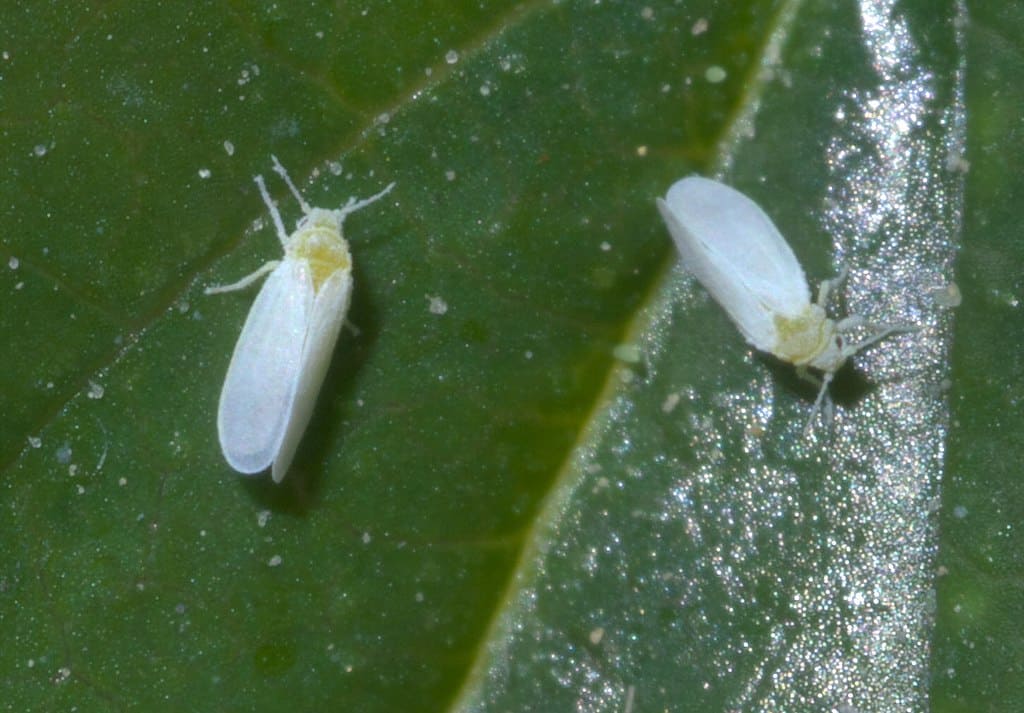
Females lay eggs that hatch into very tiny, pale green nymphs, which crawl to new parts of a plant to feed, molting through several instar stages before pupating into adults. At any given time, all stages of the whitefly lifecycle will be present on a plant, making effective treatment against these pests all that more difficult.
Signs Your Houseplant Has Whiteflies
Likely the most obvious sign you are dealing with a whitefly infestation is the rising cloud of white specks that appear anytime a plant is disturbed. Although mostly considered more of a nuisance than any real threat to your houseplants, whiteflies can actually do some real damage to your plants if allowed to go untreated for long enough.
Aside from visual identification of the adults, you may find your plant suffering from damage caused by whiteflies feeding, which they do at almost every stage of their lifecycle.
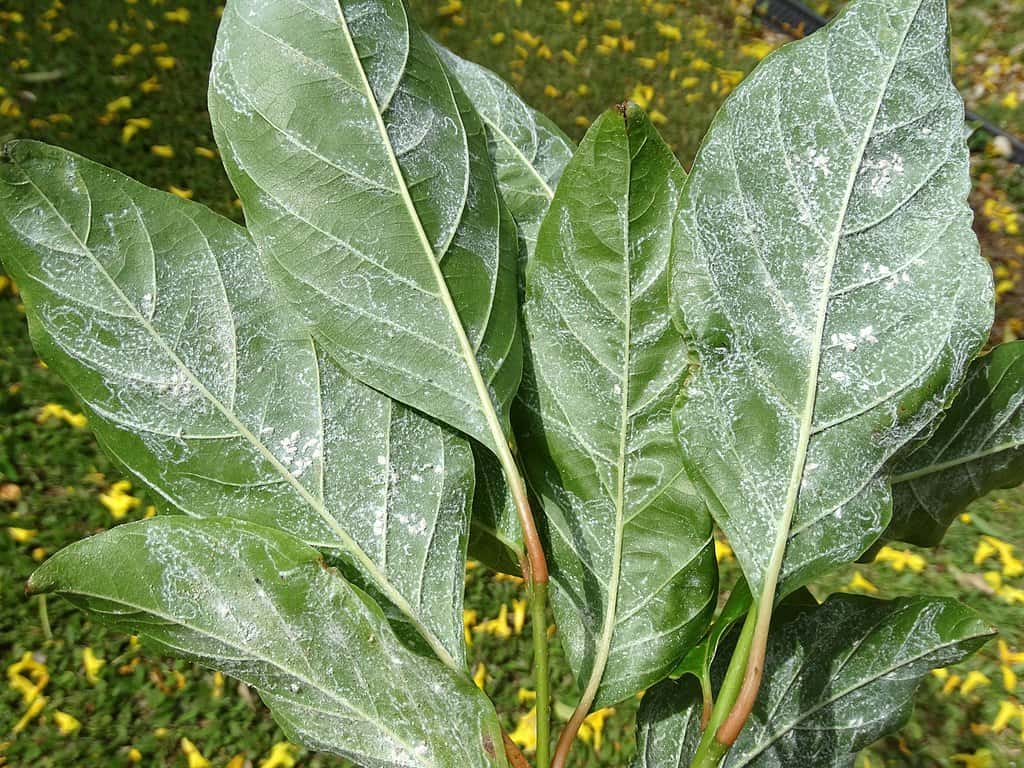
Whiteflies are sap-sucking insects, which means they pierce their mouthparts into the plant’s tissue to access the phloem, which is the transport system that moves water and nutrients to all parts of the plant.
As they feed on sap and their damaged compounds, you might see yellowing leaves or an overall loss of vigor in the plant, like wilting or drooping.
Whiteflies, like aphids and scales, also produce honeydew, a sticky excrement that coats plant structures and promotes other pests or the growth of fungal diseases. If you begin to see leaves and stems coated in a sticky, shiny substance, look closely for signs of whiteflies.
Where Do You Find Whiteflies on Your Plant?
Whiteflies are so prolific on indoor plants because they are great hiders. Fully-formed adults are usually pretty easy to identify, as they take flight when the plant is disturbed, but other life stages might be harder to find.
Whiteflies can be present on any part of a plant at any time, but they tend to seek the protection of harder to reach places, such as the underside of leaves, between stem branches, or tucked into rather dense foliage. This behavior protects them from both predators and extreme environmental conditions.
What Is the Life Cycle of a Whitefly?
Whiteflies have multi-part lifecycles that only take about 18-21 days from egg to adult. All stages occur on plant foliage, not in the potting soil. Warmer temperatures tend to speed the lifecycle up, which is why the indoor population can grow out of control quickly.
Adult female whiteflies can lay roughly 200-400 cigar-shaped eggs in their lifetime, usually producing them in clusters of 30-40 on the undersides of plant leaves. Within a matter of days, these eggs will hatch, producing the pale green nymphs that crawl toward new parts of the plant and settle to begin feeding on sap.
These juvenile nymphs will continue to molt through several intermediate stages until they reach a non-feeding stage, where they attach themselves to the leaf and rest until they pupate into winged adults.
At any given time, you can find all stages of the whitefly lifecycle present on your plant, allowing the population to build very quickly. Outdoors, cooler or freezing temperatures will slow or stop whiteflies from reproducing, but populations can skyrocket indoors, where temperatures tend to remain ideal year-round.
How Do You Treat for Whiteflies?
One of the more interesting facts about whiteflies, and the main reason they are such difficult pests to eliminate, is that they tend to become resistant to many of our best chemical treatment options available for other pests.
That being said, there are still plenty of options at your disposal for successful whitefly treatment. These mechanical methods require thoughtful application and repetition to be most effective.
Unfortunately, none of them are a guaranteed silver bullet, so you’ll need to continue monitoring your houseplant in the long term to make sure there isn’t a resurgence of whitefly later on.
Quarantine Your Plant
Let’s get the most important thing out of the way up front. If you notice one of your houseplants has a whitefly infestation, it is important to immediately quarantine your plant away from the rest of your collection.
It may sound obvious, but whiteflies, well…fly! Any houseplants placed near the host plant are in immediate danger of being the next victim of an infestation.
Move your infested plant to an area well away from any other plants, preferably in a room that can be shut away from the rest of your home. Aim for a spot that tends to stay cooler, as the drop in temperature will slow their growth cycle down.
You’ll also want to assess your plant and make sure it has everything it needs to stay strong. Proper watering and nutrition go a long way in keeping a plant healthy enough to not succumb to the stress of a pest infestation and the damage they inflict.
Spray or Wipe with Water
Whitefly control begins with the physical removal of as many insects as possible, helping knock their population back to a much more manageable number.
Spraying your plant with water, as long as it is hearty enough for that, is a great way to blast away whitefly at all stages of the lifecycle. While it’s true that many adults will likely take flight, and adhered and protected egg clusters might not dislodge, a strong stream of water can remove a good portion of juveniles in various stages.
Also, wiping the underside of leaves with a damp cloth is another effective physical removal method that targets not only juveniles but egg clusters and pupating intermediates that are almost new adults. This method can be tedious and difficult to carry out, depending on the size of your houseplant.
Adding some dish soap to the water you spray or wipe on your plant will have the added benefit of working to dissolve whiteflies’ waxy protective cuticles, making any insects left behind more susceptible to desiccation.
Yellow Sticky Cards
Another great tool that helps physically remove adult whiteflies are yellow sticky cards. These work just like old-school fly traps. Whiteflies are attracted to the color yellow, so as they bump up against a card set up within the foliage of the plant, they get stuck to the sticky surface, where they eventually die. This greatly reduces the number of fertile adults that have the potential to lay eggs.
These cards are also great tools to monitor your plant in the coming weeks after you get your whitefly problem under control. Periodically checking if any new whiteflies are getting stuck to these cards will alert you early to any potential reinfestation.
Insecticidal Soap
Once you’ve deployed a few methods of physically reducing the number of whiteflies on your plant, you can begin to incorporate coverage methods that include a variety of different sprays.
One such spray is insecticidal soap. Most formulas of insecticidal soap are a mixture of fatty acids mixed in water as a ready to use spray. These fatty acids work to dissolve protective cuticles and disrupt the cellular membranes of the insects, making them vulnerable to dehydration, desiccation, or suffocation.
It works on contact only, though, so good coverage on all parts of the plant, especially the undersides of leaves, is essential for better control.
Neem Oil and Other Horticultural Oils
Similar to soaps, Neem oil, and other horticultural oils do a great job of covering and suffocating whiteflies at all stages of growth. The oil covers insect bodies and gums up their respiratory parts, making it difficult for them to breathe.
Neem oil has the added benefit of having natural pesticidal and fungicidal properties in it, making it a good tool to not only deal with the whiteflies, but to prevent secondary outbreaks of fungal infections caused by the buildup of honeydew. It (along with good, old soapy water) will also do a good job of washing away excess honeydew, effectively cleaning the plant while treating for pests.
Once again, good control comes from good coverage, so be prepared to really get in there and spray all surfaces of the plant. In order to fully eradicate whitefly, you’ll likely need to repeat this treatment several times.
Chemical Sprays
Whiteflies adapt quickly and have, therefore, built up resistance to many chemical insecticides. This is part of the reason they are so hard to eradicate. However, certain sprays still work, depending on the species, so you might try a chemical spray if other physical or coverage methods aren’t working well.
Pyrethrin sprays are generally very safe to use indoors and on houseplants, as the insecticide it contains is naturally derived from chrysanthemum flowers. There are several different formulas, all with differing efficacies against whitefly, but they might be worth a shot if you’re finding control of these pests elusive.
Read labels carefully, however. Some formulas add synthetic chemicals to the pyrethrin to make the product stronger and more effective, but that also may limit what you can spray and where. Make sure you are comfortable with the product before spraying, especially indoors.
Other Spray Tactics
Above and beyond the options above, there are plenty of other spray treatments you can deploy to target whiteflies, all with varying degrees of success.
Apple cider vinegar, rubbing alcohol, and hydrogen peroxide can all be mixed with water at various strengths to be used as a spray. These all work to dissolve the protective waxy cuticle of the whiteflies’ bodies, causing desiccation.
However, regardless of what you are using and at what strength, you should always plan to test these sprays on a small portion of the plant first to see if there are any negative effects. Many houseplants have a waxy cuticle covering their leaves to protect delicate structures and systems, so repeated applications of a too-strong solution might begin to break down these plant structures, causing issues far worse than whiteflies.
If you do test before use, wait several days and monitor the plant for any signs of distress before you apply your solution to the entire plant.
Diatomaceous Earth
Diatomaceous Earth is a fine powder made from the remains of tiny, aquatic organisms called “diatoms”. These diatoms have shells made of silica, which, when dried out and broken down, create jagged shards that can cut and destroy soft-bodied insects.
DE can be an effective treatment against whiteflies when applied as a dry powder, although the application can be difficult or tedious, depending on the size and texture of your plant. Using a fine shaker to distribute the powder over plant surfaces works well. Alternatively, you can use a paintbrush to gently coat the underside of leaves with DE.
The good thing about diatomaceous earth is that it will target all stages of a whitefly’s lifecycle, from eggs and nymphs to any adult that lands on the surface of the plant. You’ll likely need to reapply DE several times to ensure good coverage, but once you feel like you’re getting good control, it washes off easily under a gentle spray of water.
Throw Out Your Plant
If you’ve been fighting the good fight and don’t seem to be making any headway against the whiteflies, or if you really don’t want to put the time and energy into it, one very effective way of nipping an infestation in the bud, is to just throw your plant out.
While many will balk at the mere suggestion of it, I offer this option to you because, when it comes down to it, whiteflies are tough to get rid of and very easily spread from plant to plant. Rather than risking a full home invasion, the most logical option might be just to remove the entire population in one go.
Obviously, if a prized and rare specimen is infested, you might want to work harder to save it, but let’s face it, most houseplants are pretty generic species that can easily be replaced for about $20.
If you want to throw out your infested plant, I suggest removing any nearby plants first before bagging the entire plant and pot in a plastic garbage bag, ensuring you cover the whole thing before the adult flies try to flee. Tie the bag tight and take it outside, where you can remove the pot before placing it in the trash.
If you plan to reuse the container, scrub and disinfect it well so you’ll be able to ensure there aren’t any whiteflies stowing away on it.
Final Thoughts
Although mostly a nuisance rather than an acute threat to houseplants, whiteflies are notoriously difficult to eliminate. However, knowing how they reproduce, feed, and spread will go a long way in choosing how you fight them.
Physical removal of the pests, either from wiping, spraying, or using sticky cards, is a good start, but you’ll also want to include some type of coverage spray that targets all stages of their lifecycle.
The best control comes from precise applications, thorough coverage, and repetition. Be smart and meticulous about how you utilize your treatment methods, and these infamously persistent pests won’t stand a chance. Good luck!







